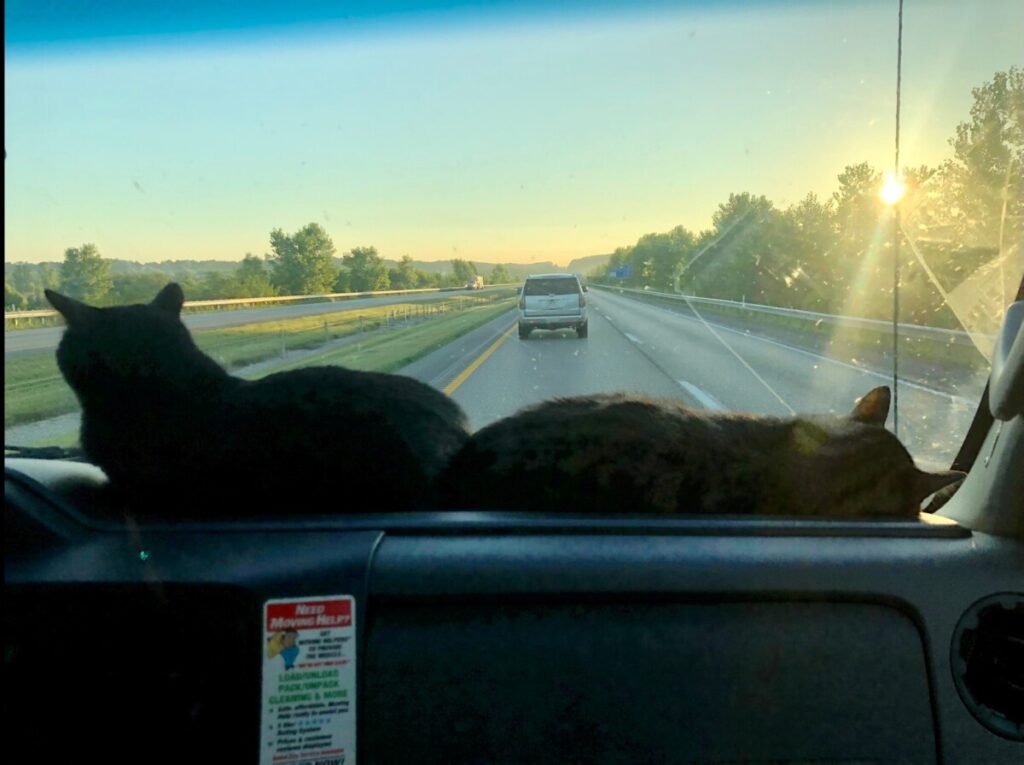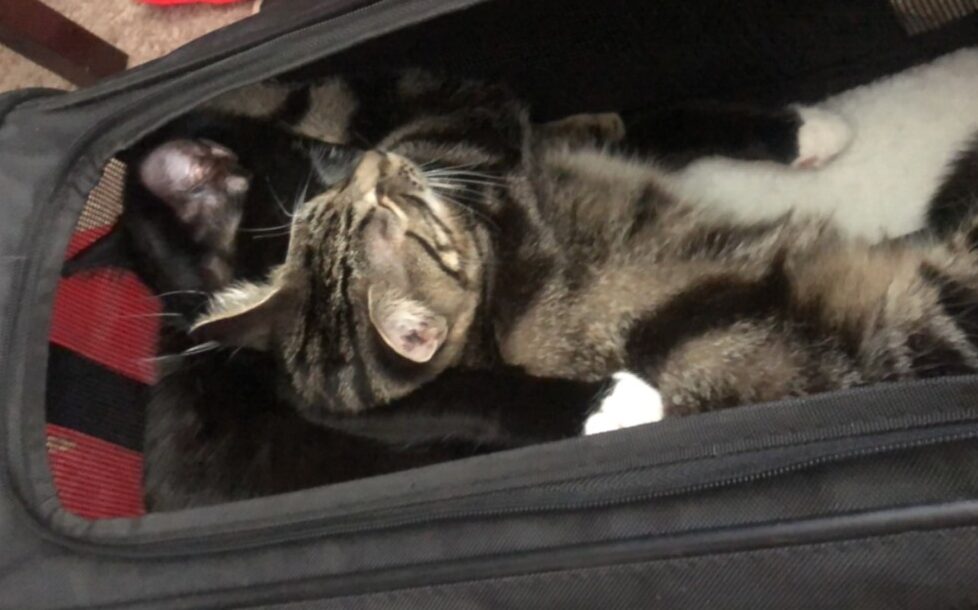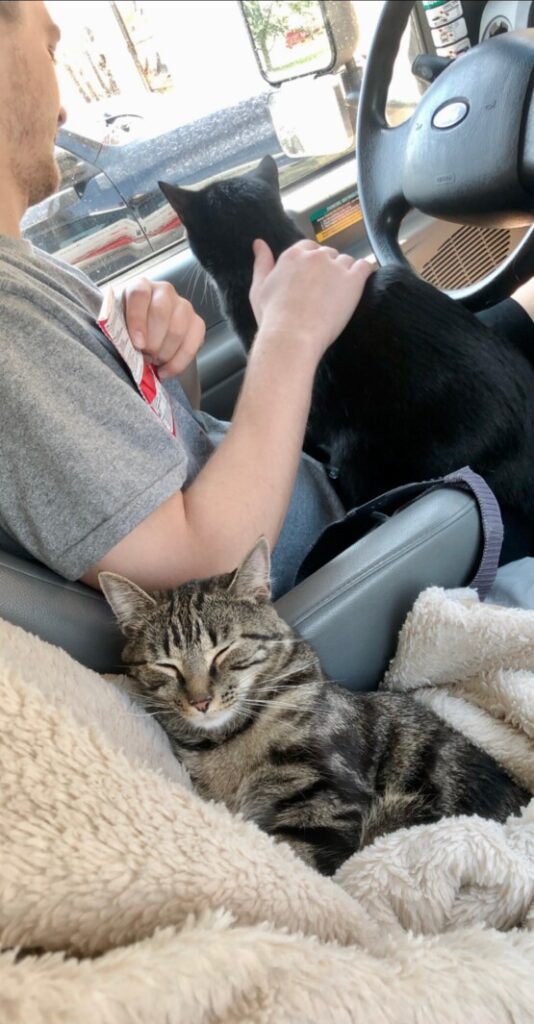Moving across the country is both exciting and stressful. While you’re getting ready for the move, it’s important to prepare your cat for the trip as well.
When you’re moving across the country with your cat, give them time to get used to their carrier, pack everything you’ll need in advance, and plan for breaks on the road if you’re driving.
I’ve moved across the country with my cats three times over the past five years, and each time I learned new and better ways to make the trip less stressful for them.
In this article, I’ll share everything I wish I knew the first time I moved across the country with my cats.
Moving Cross Country With Cats: How To Move a Cat Long Distance
If you’re getting ready to move across the country, congratulations on starting this new journey! As a cat parent, you’re likely already used to considering your favorite feline friend in any major (or minor) life decision, and it’s more important now than ever.

The first time I moved across the country with my (then) two cats, I made every mistake in the book. I wish I could apologize to them for all the stress I caused by not properly preparing. However, I learned a lot and my cats seem to have forgiven me. I’ve moved cross country with them twice since then, and each time has been smoother than the last.
Now, there are 10 things I know to do if we ever move across the country again. In this article, I’ll share each of these 10 steps to make your cross-country move as stress-free as possible for your cat.
1. Go to The Vet
Once you’ve decided to move across the country with your cat, one of the first things you should do is take them to the vet. Make sure they’re healthy enough to travel in a car for long distances or to be on a plane.
You’ll also want to make sure your cat is up-to-date on all of their shots. If you’re flying, be sure to research the specific vaccine requirements for your destination. You can find this information for the U.S. on the APHIS website here.
2. Update Your Cat’s Microchip and ID
If your cat doesn’t already have a microchip, be sure to get one before you move. This is a great way to ensure some peace of mind if your cat gets a little too adventurous. You can get your cat microchipped at many major pet stores or by your regular veterinarian.
Once your cat is microchipped, you can update your contact information through the company that supplied the chip. You can find a list of microchip companies and websites where you can update your cat’s microchip information on the Animal Humane Society’s website here.
In addition to updating their microchip information, be sure to also have a collar on your cat with up-to-date contact information during the move. Any steps you can take to ensure your cat gets returned if they’re lost during the move will offer additional peace of mind.
3. Make a Travel Plan Including Pet-Friendly Hotels
Once your cat is ready to travel, focus on the finer details of your travel plan. This is especially important if you’re driving cross country with your cat. You’ll likely need to stay at least one night on the road, which means you’ll need to stay at a pet-friendly hotel.
You can search for pet-friendly hotels on Google Maps where you plan to stay. When we moved across the country, we tried to stop around the halfway mark. Based on how long your cat can stay in their carrier and travel in the car, you may need to stop sooner or stay more than one night on the road. Be sure to plan for this just in case, especially if it’s your cat’s first big trip.
To figure out how much it will cost to take your cat with you on your cross-country move, I’ve included a detailed guide later in the article.
4. Get Your Cat Carrier As Soon As Possible
Whether you’re driving or flying, be sure to get an appropriate cat carrier as soon as possible. The longer you can have the cat carrier out in your current home, the more time your cat will have to warm up to it.

If you’re flying, be sure to get a cat carrier that’s airline-approved. No matter how you’re traveling, make sure you get a carrier that’s big enough to keep your cat comfortable. You’ll also want something that’s waterproof, properly ventilated, and escape-proof. You may even want a cat carrier that comes with its own travel litter box.
Once you have your cat carrier, set it out in your current home. Allow your cat to explore it. Slowly start to put your cat’s favorite toys and treats inside the carrier. Once your cat is entering the carrier willingly, try closing it. Then, slowly start picking it up, walking your cat outside, and getting them used to being in the car before the move. This will help reduce stress greatly when it’s time to go.
5. Pack Everything You’ll Need Ahead of Time
Obviously, if you’re moving, you’re already packing or getting ready to pack. Take your cat into consideration during the process and pack accordingly.
Here are a few things you’ll want to have on hand during the move:
- Your cat carrier
- A harness and leash
- A travel litter box with litter
- Food and water bowls
- Cat food and bottled water
- Treats
- Your cat’s health records and travel documents
- Comfort items (familiar toys, blankets, etc.)
- Emergency cleaning supplies (in case your cat gets sick)
You can check out a list of the best cat carriers with litter boxes included here. Also, be sure to check out these 6 best food and water bowls for traveling cats.
6. Use Calming Aids to Reduce Stress on the Trip
Calming aids can come in handy for anxious cats. There are several options available now, so I recommend getting one or two calming aids and trying them out at home before the move to see what your cat responds to best.
You can try a cat calming spray, pheromone wipes, special-made treats, calming collars, or even a vest designed to reduce anxiety.
During your vet visit, talk to your veterinarian about calming aids. If your cat is especially anxious, your vet may even prescribe a mild sedative to help your cat relax during the trip. Even if they do, I recommend trying it out early to see how your cat will react.
7. Watch Your Cat Closely on Moving Day
Cats can sense change. On moving day, your cat will likely know something is up. They may even be more apt to dash through an open door or hide. For this reason, it’s important to watch your cat closely on moving day.
I recommend putting your cat in their own room or even in their carrier before you start loading your car. If you have movers coming, be sure to let them know that you have cats.
Also, withhold your cat’s breakfast on moving day. I did not do this before our first cross country move (surely she’ll get hungry?!) and she threw up an hour into the ride. Unless told otherwise by your vet, do not feed your cats breakfast on moving day. They will be fine until you get to your evening destination.
For more information on what to do with your cats on moving day, read our full guide here.
8. Keep Your Cat Comfortable in the Car
Whether you’re driving or flying, keep your cat as comfortable as possible.
If you’re flying, your cat will likely have to stay in their carrier the entire trip (after you get through TSA.) But if you’re driving, you have a little more flexibility.
Make sure your cat’s carrier or restraint is securely fastened in your car, and make sure they have a little bit of space. You don’t want the sun beating directly down on your cat during the drive, and you don’t want things completely covering their carrier limiting their airflow.
When we drive with the cats in the car, I try to make sure the air is flowing around them and that they can see out of their carriers. I also like to position them in a way that I can see them so I can check on them throughout the trip.
9. Check-In With Your Cat Regularly and Stop as Needed
Speaking of, make sure you do check in on your cat regularly throughout the trip. For a full guide on how long your cat can travel before needing a break, check out this article.
Again, if you’re flying, you won’t be able to take them out of their carrier until you land. However, if you’re driving, you can give your cat a break from their carrier when they need it.
Look for signs of anxiety from your cat as you travel. If they start panting or getting restless, it’s time to pull over and let them out of their carrier for a bit. You can roll up the windows and lock the doors to let them wander around the car or use a harness and leash to safely let them out.

10. Return to a Routine Once You Arrive
Once you arrive at your new home, return to a routine as soon as possible. Set up a safe space for them with their litter box, food, water, and their cat carrier. This has been their home for several hours (may even a couple of days) and they may return to it for a while.
As you move in, you may even want to confine your cat to a smaller safe space like a bedroom or bathroom. This will reduce the chances of your cat running out of an open door. Plus, it’ll be a calmer space to hang out in while you start to set up your new home.
Staying at a Hotel With a Cat
If you have to stay a night or two on the road during your move, be sure to find a pet-friendly hotel ahead of time.
When we’ve moved across the country, here are the steps I’ve taken to find a hotel in advance:
- Pull up the drive on Google Maps or a similar app
- Identify the nearest town or city to the halfway mark (or whenever you plan to stop)
- Search for pet-friendly hotels in the area
- Make a list of 3-5 hotels and save their phone numbers and addresses
- When you get close to the town or city, call hotels to check availability and get rates for the night
When you arrive, keep a close eye on your cat. Their routine has been disturbed and they’re likely to be anxious and want to run or hide.
You may even want to confine them to a smaller overall space for the night like your hotel room’s bathroom.
Before you even let your cat out, set up a safe space for them in your hotel room. This should include their litter box, food, water, and their cat carrier. Also, be sure to bring comfort items from home including your cat’s favorite toy, familiar blankets, etc.

Using a Cat Sedative for Travel
One commonly asked question when it comes to moving across the country with a cat is whether or not you should use a sedative.
The first two times I moved across the country with my cats, I did not use a cat sedative. One of my cats had some anxiety the first hour of the trip, but overall everyone was fine. However, on my third trip across the country with my cats, I asked the vet to prescribe medication.
By that move, I’d adopted a third cat that was far more anxious than my other two. Our vet gave us a generic brand of gabapentin, which was a powdered medication in pill capsules.
She instructed us to break open the capsules and split the contents between a small amount of food for each of our three cats about an hour before we got in the car. It worked really well for us, and if we move again, I’ll likely look into the same prescription.
Some common medications that may be prescribed by your veterinarian include the following:
- Buprenorphine (Buprenex®, Simbadol®)
- Gabapentin (Neurontin®)
- Aalprazolam (Xanax® and Niravam®)
Source: Tammy Hunter, DVM; Robin Downing, DVM, CVPP, CCRP, DAAPM
Only give your cat medications as prescribed by your vet. Ask your vet about giving your cat a small dose of the medication prior to moving to make sure they’ll respond positively to it.
How Much Does It Cost To Transport a Cat Across Country?
When you’re moving across the country, expenses are a huge part of planning. If you’re wondering how much it will cost to transport your cat across the country, it depends on how you’re traveling.
The average cost to fly with your cat one-way is an additional $111. Traveling with your cat by train costs $26 for up to seven hours. Driving with your cat depends on how far you’re traveling, the current cost of gas, and whether or not you’ll need to stay in a pet-friendly hotel overnight.
If you’re flying with your cat, you can expect to pay for your plane ticket, luggage, and a carry-on cat carrier. Here’s how much a carry-on pet carrier costs at a few major airlines:
- Alaska Airlines: $100
- American Airlines: $125
- Delta: $125
- Frontier: $99
- Southwest: $95
- Spirit: $110
- United: $125
If you’re taking the train, cats can travel up to seven hours on most Amtrak routes for $26.
Most likely, you’re driving. If that’s the case, the cost to bring your pet will only depend on gas and whether or not you’ll have to stay at a pet-friendly hotel.
To figure out how much gas will be, follow these steps:
- Use Google Maps to figure out how many miles you’ll be driving
- Look up your car or Uhaul’s average MPG
- Look up how many gallons of gas your car or Uhaul holds
- Find the current average cost of gas on AAA’s website here
- Use this formula:
- Your car’s MPG x how many gallons it holds
- Distance to travel ÷ your first answer (this is how many times you’ll have to fill up)
- The cost of gas x how many gallons your car holds (this is how much it costs to fill up)
- Multiply those two numbers
For example, if I’m moving 1,200 miles, and my car holds 17 gallons of gas and gets 25 MPG, the formula would look like this:
- 25 (MPG) x 17 (gallon tank size) = 425
- 1,200 (distance to travel) ÷ 425 = 2.8 (how many times I’ll have to fill up)
- 3.33 (current gas price) x 17 (tank size) = 56.61 (cost to fill up)
- 2.8 x 56.61 = $158.51 total for gas
Finally, be sure to call ahead to pet-friendly hotels in the area you plan on staying in to get quotes on nightly rates.
Moving Into a New Home With a Cat
Once you’ve successfully driven or flown across the country and made it to your new home, the most stressful part is behind you and your cat. Now, you can focus on acclimating your cat to your new home.

During the first few days, it may be best to introduce your cat to only one room in the new house. Your bedroom could be a good place to start.
Keeping your cat in one room while you move in can help to avoid accidental escapes and loud/hectic situations for your cat. Just make sure to spend some time with them in their room to help them feel comfortable.
Set up a safe space for your cat there with the following items:
- Their cat carrier
- Litter box
- Food and water bowls
- Comfort items from home (favorite toys, blankets, etc.)
- Cat calming diffuser (if your cat is particularly anxious)
After you’ve moved in and your cat seems to be comfortable with the room they’re in, you can start introducing them to the rest of the house. Watch for hiding spots, anything they could eat or hurt themselves with, and any cracked doors or windows.
Even if you regularly let your cat outside, it’s important to keep them inside for at least two weeks after you’ve moved. This will reduce the chances of them getting lost or hurt in their new surroundings.
Final Thoughts
Moving across the country with your cat can be both exciting and stressful. Before you hit the road, take the time to prepare properly so that your cat can be as comfortable as possible.
Get your vet visit out of the way and get your cat carrier as soon as possible. Also, be sure to update your cat’s microchip and ID before moving day. Plan your trip ahead of time, including time for stops, and be sure to pack everything your cat will need on the road.
Talk to your vet about calming aids and cat sedatives, and try them out at home in advance. When moving day comes, watch your cat closely and remember to withhold their breakfast until you’re done traveling for the day.
As long as you check in with your cat regularly and acclimate them to their new home appropriately, they should begin settling down and adjusting a few days or weeks after the move.
As always, be patient with your cat as they get used to the change. Finally, establish care at a new vet as soon as possible once you’re moved in.
Related Content To Help You Prepare for Your Move:
- Moving With Cats: What To Do on Moving Day
- 8 Best Cat Carriers With Litter Box
- Is Your Cat Carrier Airline Approved?

